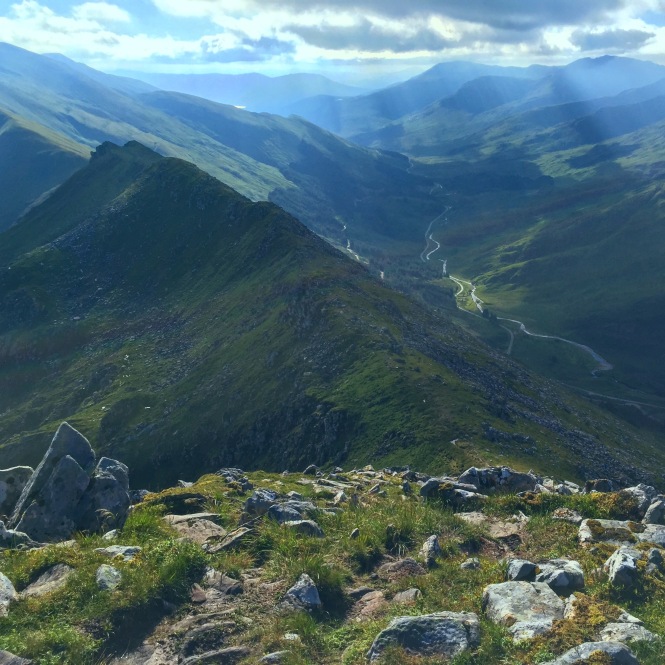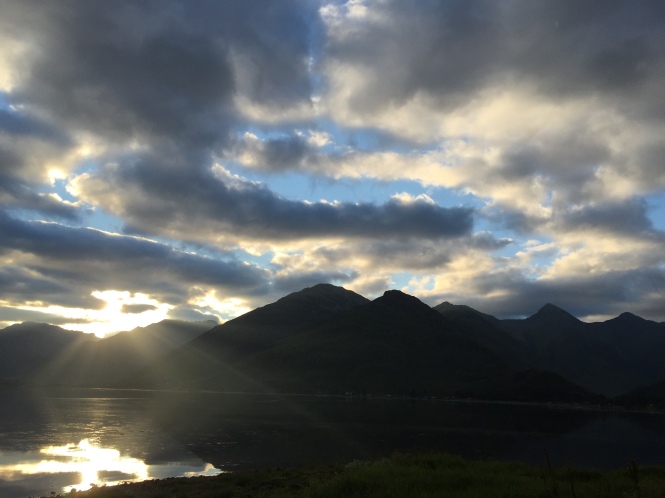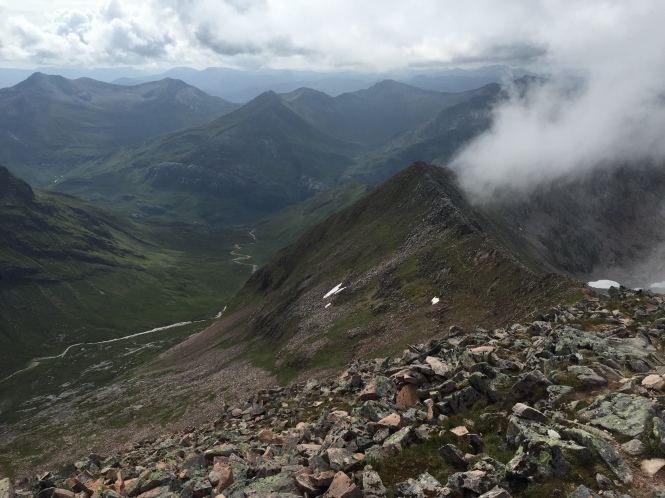It’s a dreadful cliché. I found God on a mountain top. But to avoid the very worst of it, it wasn’t on the top that my epiphany came but about halfway up the side of my third Munro of the morning.
 Towards the end of the nineteenth century Hugh Munro decided to list all of the peaks in Scotland over 3000 foot, along with their subsidiary peaks. In true British fashion he didn’t set out clear criteria for what distinguished a Munro from a top, and over the last century many impassioned debates have raged over whether a particular peak is a Munro or a top. Every ten years or so the list is reassessed and the task of reaching all the summits becomes either a little easier or just a bit harder.
Towards the end of the nineteenth century Hugh Munro decided to list all of the peaks in Scotland over 3000 foot, along with their subsidiary peaks. In true British fashion he didn’t set out clear criteria for what distinguished a Munro from a top, and over the last century many impassioned debates have raged over whether a particular peak is a Munro or a top. Every ten years or so the list is reassessed and the task of reaching all the summits becomes either a little easier or just a bit harder.
Across Scotland there are 282 Munros, from those that just squeak over the threshold to Ben Nevis which at 4,409 feet is the highest point in the UK. While wandering over a few peaks, and talking to other walkers, I came across the challenge to climb them all. It’s a natural sort of endeavour – there are a lot of peaks, and people want to have reached the summit of them all. But 282 is quite a lot. During my week in Scotland I climbed eight, if I took such a trip every year it will take me 35 years, if by the age of 66 I’m walking up my last Munro, I will have achieved something both petty and significant.
Hills are not changed by walking up them. Most of them do not have clearly marked paths up their route, they may have a slight trail that ebbs and flows and disintegrates into a wide scree slope before emerging once again. If each year I tick a few more off my list my calves will stay in shape and I will hopefully retain some of my fitness, but apart from the achievement of getting to all of the places over an arbitrary height I will have achieved very little.
But walking up hills is constantly teaching me lessons. When in June my friends and I failed the Welsh 3000s I learnt a little about the burden of leadership. And a further lesson that was birthed then and grew a little more this past week in Scotland was that going slow is not a weakness.
In fact, when it comes to mountain walking, going slow is the fastest approach. I’m not a seasoned hill walker, but I like to think that I’m learning a few important lessons pretty quickly, and the one that makes the most difference is to walk slower than you think is necessary. The first walk I took in Scotland, over the Five Sisters of Kintail, was quite an initiation. I parked the car, looked at the map and instructions and saw the ridge towering above me and a wooden sign leading to a narrow path (which would frequently disappear) heading up 700 metres of steep grassy slope. And from the ridge I climbed the first summit, and then the next, and I think on the fourth or fifth occasion actually reached the top of my first Munro. And inevitably, to reach the next I had to first go down, and then up, and then down, and then up. By the end of the first day I’d covered over 20 miles, waded through bog, probably trespassed across a farmer’s land, listened to a couple of sermons and a couple of episodes of the NPR All Songs Considered podcast, and I was tired.
After a day’s break I set off to climb another two Munros. This time I was based at the most remote Youth Hostel in the UK, a mile walk from Corrour station, where there’s no public road access, the Ordnance Survey map of the region has just two tiny bits of road clipping the corners. Here, by Loch Ossian, with millions of midges for company, in a hostel powered by solar and wind power alone, with strict instructions to take out everything you bring in, I set out on my own once again. I met just a couple of other walkers that day. One who had walked in the night before, stayed at an even more remote bothy before climbing the hard to reach Ben Alder before walking back to the station on the second day. Getting to some of the 282 Munros is not an easy business. It’s not the sort of thing you can race around and do (although, of course, some do: the record for a round of all the summits is about 40 days).
With Rannoch Moor stretching to the south and east, the Ben Nevis range to the west, and the Great Glen to the north this is the closest to the middle of nowhere you can get in the UK. To find the hostel the site of drunken escapades in the middle of the following night was a little unexpected. Fire alarm set off at four in the morning, sick on the front porch, empty bottles scattered by picnic tables on the edge of the loch. Unconfirmed report that one of the late night revellers had fallen into the loch. It was dissonant.
The final day’s walking was based out of the Glen Nevis youth hostel – from the lack of civilisation to the lack of tranquillity. Ben Nevis is a tourist’s mountain. The main track leading from the glen up to the peak is variously known as the pony track, the mountain track, or, the tourist track. I was glad to be not walking up on a weekend. I also opted to start early and take an alternative route, which meant another gruelling ascent up onto the first subsidiary peaks of Carn Mor Dearg, Ben Nevis’s far lesser known neighbour – but at over 4,000 foot still a considerable climb, and a far more interesting one that it’s more prominent neighbour.
Ben Nevis is basically just a giant lump of rock, Carn Mor Dearg is a proper peak, which rises and falls before reaching its final height. What attracted me to this route, but also set my nerves sparking as I approached, was the transition between the two Munros known as the CMD Arête. This is a ridge that curves around for over a kilometre before presenting the walker with a final rocky scramble to Ben Nevis’s peak. The ridge wasn’t as precarious as I feared, or it looked, and for the scramble I was grateful to follow a pair who stayed a helpful distance ahead. And then suddenly I was on the top, from the fairly lonely exertion with hands and feet pulling body over rock after rock, to a summit plateau populated with hundreds of walkers who had made their way to the top. Selfies proliferated, parents insisted children posed, sandwiches feasted on, water bottles quaffed.
Carn Mor Dearg did not have the remoteness of some of the other climbs I did, but it certainly had the difficulty, it was very hard work on the legs. And it called for slowness. Although not crowded, there were enough other walkers on it’s ascent to notice our respective speeds. It was with some smugness that I let people pass me on the early stages, and then keep on going as they had to stop to catch their breath. Towards the top a couple raced past me, only to fall back before reaching the summit. I knew that I might be walking slower, but I had the confidence it would enable me to get there first.
Somehow I was gaming it all. I was pretending not to hurry but perhaps had just learnt that it was the fastest course.
In life I hurry all the time. I like to move from one thing to the next and the on to the next, with each consecutive thing providing stimulation and excitement. I cope with solitude well, I cope with stillness appallingly. I also burn out. I run out of energy, I start to fall apart. At the end of three weeks of holiday I’m only beginning to feel rested. Each day I set myself tasks and the thought of waking up without anything to do fills me with borderline horror.
Going slow is not just key to getting up mountains, perhaps it’s a lesson for much of life. Sometimes I’m far too slow, too deliberative, too inactive, sometimes I’m paralysed by indecision. But I think there’s value in slow plodding, setting a course, and working your way towards it, step after step, even if each takes longer than the last. Eugene Peterson wrote a book, ‘A Long Obedience in the Same Direction’, the title caught my attention long before I got around to reading it.
It comes from a section in Nietzsche’s writings, and he had to fight his publisher to use it for the title. The wider section in the original goes: “The essential thing ‘in heaven and earth’ is … that there should be a long obedience in the same direction; there thereby results, and has always resulted in the long run, something that has made life worth living.”





[…] the last month I posted twice, on learning to stop hurrying and attempting to define leadership. Neither of those posts got as many views in the past month as […]